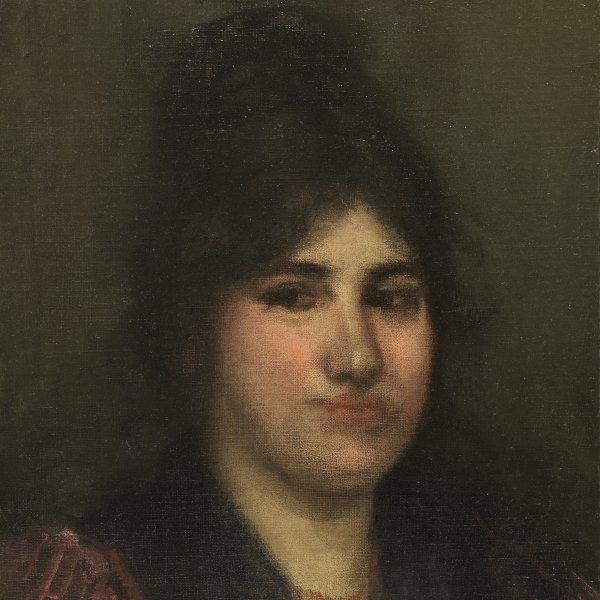James McNeill Whistler
Lowell, 1834-London, 1903
Although an American, the painter James McNeill Whistler spent most of his life in Europe. Immersed in the latest artistic trends, he became a bridge between Europe and America and an example for new generations of American artists to follow.
Son of a civil engineer, Whistler spent his childhood in various parts of the United States and also in Saint Petersburg, where he received his first drawing classes. In 1848 he furthered his training in London, where his brother-in-law Francis Seymour Haden acquainted him with the art of engraving. In 1855, after living in the United States for a few years, he decided to go to Paris to become a professional painter. He studied at the École Impériale et Spéciale de Dessin and in the workshop of Charles Gleyre. In the city he met the artists Henri Fantin-Latour and Alphonse Legros, with whom he formed the Société des Trois. Like them, Whistler greatly admired Velázquez, seventeenth-century Dutch painting and his contemporaries Gustave Courbet and Édouard Manet.
One of his works, At the Piano (Cincinnati, Taft Museum), was rejected by the Salon in 1859. A few years later he moved to London, where the same work was exhibited at the Royal Academy and where Whistler spent most of his life thereafter. He came into contact with the Pre-Raphaelite circle and befriended Dante Gabriele Rossetti and the poet Algernon Swinburne, as a result of which his work shifted from realism to a greater aestheticism. Barely two years after his arrival in London, his painting The White Girl (Washington, National Gallery of Art) triggered a major controversy as it was rejected by the Royal Academy and the Salon, and aroused great expectation at the Salon des Refusés in 1863. The bewilderment he caused among public and critics alike became evident again in 1877, when John Ruskin harshly criticized one of his nocturnes. Whistler sued him for libel and, although he won the case, the legal costs forced him to declare himself bankrupt in 1879.
Whistler’s ever latent interest in graphic art grew after he married one of his students, Beatrice Godwin, in 1888. He travelled with her to Venice and lived in Paris with her until she died in 1896.
Whistler’s work began to be appreciated in the last period of his life. After his death, in 1903, commemorative exhibitions were held at the International Society in London and the École des Beaux-Arts in Paris.
Son of a civil engineer, Whistler spent his childhood in various parts of the United States and also in Saint Petersburg, where he received his first drawing classes. In 1848 he furthered his training in London, where his brother-in-law Francis Seymour Haden acquainted him with the art of engraving. In 1855, after living in the United States for a few years, he decided to go to Paris to become a professional painter. He studied at the École Impériale et Spéciale de Dessin and in the workshop of Charles Gleyre. In the city he met the artists Henri Fantin-Latour and Alphonse Legros, with whom he formed the Société des Trois. Like them, Whistler greatly admired Velázquez, seventeenth-century Dutch painting and his contemporaries Gustave Courbet and Édouard Manet.
One of his works, At the Piano (Cincinnati, Taft Museum), was rejected by the Salon in 1859. A few years later he moved to London, where the same work was exhibited at the Royal Academy and where Whistler spent most of his life thereafter. He came into contact with the Pre-Raphaelite circle and befriended Dante Gabriele Rossetti and the poet Algernon Swinburne, as a result of which his work shifted from realism to a greater aestheticism. Barely two years after his arrival in London, his painting The White Girl (Washington, National Gallery of Art) triggered a major controversy as it was rejected by the Royal Academy and the Salon, and aroused great expectation at the Salon des Refusés in 1863. The bewilderment he caused among public and critics alike became evident again in 1877, when John Ruskin harshly criticized one of his nocturnes. Whistler sued him for libel and, although he won the case, the legal costs forced him to declare himself bankrupt in 1879.
Whistler’s ever latent interest in graphic art grew after he married one of his students, Beatrice Godwin, in 1888. He travelled with her to Venice and lived in Paris with her until she died in 1896.
Whistler’s work began to be appreciated in the last period of his life. After his death, in 1903, commemorative exhibitions were held at the International Society in London and the École des Beaux-Arts in Paris.





